Description
Efnisyfirlit
- Cover image
- Title page
- Table of Contents
- Copyright
- Dedication
- Contributors
- Foreword
- Preface
- Acknowledgments
- Section I Key Aspects of Clinical Documentation
- Chapter 1 Disablement Models and the ICF Framework
- The Concept of the Disablement and the ICF Model
- Rehabilitation Is Enablement: The Reverse of Disablement
- Functional Outcomes: More Than Simply a Documentation Strategy
- Classification According to the ICF Framework
- Summary
- Exercise 1-1
- Chapter 2 Essentials of Documentation
- Documentation: An Overview
- Types of Notes
- Purposes of Note Writing
- Documentation Formats
- What Constitutes “Documentation”?
- Evidence-Based Practice
- Strategies for Conciseness in Documentation
- Person-First Language
- Summary
- Exercise 2-1 Interpreting Abbreviations
- Exercise 2-2 Concise Documentation and Use of Abbreviations
- Exercise 2-3 People-First Language
- Chapter 3 Legal Aspects of Documentation
- Documentation as a Legal Record
- Privacy of the Medical Record: HIPAA and the Privacy Rule
- Documentation of Informed Consent
- Potential Legal Issues
- Summary
- Recommended Resources
- Chapter 4 Standardized Outcome Measures
- Levels of Measurement
- Psychometric Properties
- Instrument Selection: Choosing Appropriate Outcome Measures
- Summary
- Resources
- Chapter 5 Payment Policy and Coding
- The Big Picture of Health Care Reform and Physical Therapy
- Third-Party Payers
- Prospective Payment, Billing, and Coding
- Physician Quality Reporting System
- Summary
- Recommended Resources
- Chapter 6 Electronic Medical Record
- Evidence for Electronic Medical Records
- Electronic Records in Physical Therapy Practice
- Drawbacks to Pen and Paper Documentation
- Benefits of Electronic Medical Record
- Drawbacks of Electronic Documentation
- Uses of Patient Data from Electronic Medical Records
- Design and Implementation of a New Computerized System
- Summary
- Section II Documenting the Initial Evaluation and Beyond: A Case‐Based Guide
- Chapter 7 Clinical Decision Making and the Initial Evaluation Format
- The Initial Evaluation Format and the Patient/Client Management Model
- Description of Components of the Initial Evaluation
- Case Examples
- Conclusion
- Summary
- Exercise 7-1
- Chapter 8 Documenting Reason for Referral: Health Condition and Participation
- History-Taking for Health Conditions and Participation-Based Information: The First Step in Physical Therapy Diagnosis
- Documenting Reason for Referral
- Specificity of Documentation
- Outcome Measures
- Preventing Participation Restrictions
- Summary
- Exercise 8-1
- Exercise 8-2
- Exercise 8-3
- Exercise 8-4
- Exercise 8-5
- Chapter 9 Documenting Activities
- Defining and Categorizing Activities
- Documenting Task Performance
- Documenting Functional Activities
- Measurement of Activities
- Standardized Tests and Measures
- Summary
- Exercise 9-1
- Exercise 9-2
- Exercise 9-3
- Chapter 10 Documenting Impairments in Body Structure and Function
- Defining and Categorizing Impairments
- Systems Review
- Strategies for Documenting Impairments
- Standardized Tests and Measures
- Documenting Strength and Range of Motion
- Documenting Pain
- Summary
- Exercise 10-1
- Exercise 10-2
- Chapter 11 Documenting the Assessment: Summary and Diagnosis
- Diagnosis by Physical Therapists
- Additional Elements of the Diagnostic Process
- Assessment Section
- Common Pitfalls in Assessment Documentation
- Summary
- Exercise 11-1
- Chapter 12 Developing and Documenting Effective Goals
- The Goal-Setting Process
- A Traditional Approach: Short-Term and Long-Term Goals
- Writing Goals at Three Different Levels
- Fundamentals of Well-Written Goals
- A Formula for Writing Goals
- The Art of Writing Patient-Centered Goals: Going Beyond the Formula
- Determining Expected Time Frames for Goals
- Choosing Which Goals to Measure: Prioritizing and Benchmarking
- Goal Attainment Scaling
- Writing Participation and Impairment Goals
- Summary
- Exercise 12-1
- Exercise 12-2
- Chapter 13 Documenting the Plan of Care
- Components of the Plan of Care
- Documenting Skilled Intervention
- Documenting Informed Consent
- Summary
- Exercise 13-1
- Exercise 13-2
- Chapter 14 Session Notes and Progress Notes Using a Modified SOAP Format
- Modified SOAP Format
- Session Notes
- Summary
- Exercise 14-1
- Exercise 14-2
- Exercise 14-3*
- Exercise 14-4*
- Chapter 15 Special Formats: Screening Evaluations, Discharge Summaries, Letters, and Patient Education Materials
- Screening Evaluations
- Discharge Summaries
- Letters to Third-Party Payers to Justify Equipment or Services
- Patient Education Materials
- Summary
- Chapter 16 Documentation in Pediatrics
- Overview of Pediatric Documentation
- Early Intervention
- School-Based Intervention
- Goal Writing in the School Setting
- IDEA to GOALS
- Summary
- Exercise 16-1
- Exercise 16-2
- Resources
- References
- Appendix A Guidelines for Physical Therapy Documentation
- Preamble
- APTA Position on Documentation
- Operational Definitions
- General Guidelines
- Initial Examination/Evaluation
- Visit/Encounter
- Reexamination
- Discharge/Discontinuation Summary
- Relationship to Vision 2020: Professionalism
- Explanation of Reference Numbers
- Appendix B Rehabilitation Abbreviations
- General
- Professional
- Medical Diagnosis
- Symbols
- Abbreviations by Word
- Appendix C Answers to Exercises
- Chapter 1
- Chapter 2
- Chapter 7
- Chapter 8
- Chapter 9
- Chapter 10
- Chapter 11
- Chapter 12
- Chapter 13
- Chapter 14
- Chapter 16
- Appendix D Documentation Review Sample Checklist
- Appendix E Sample Range of Motion and Strength Assessment Form
- Index






Reviews
There are no reviews yet.